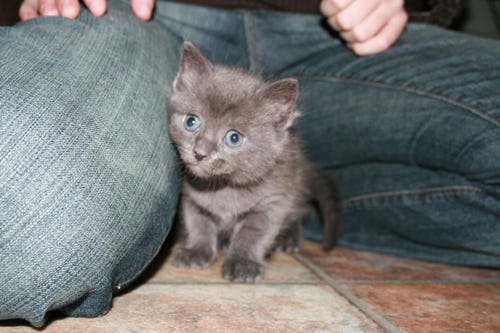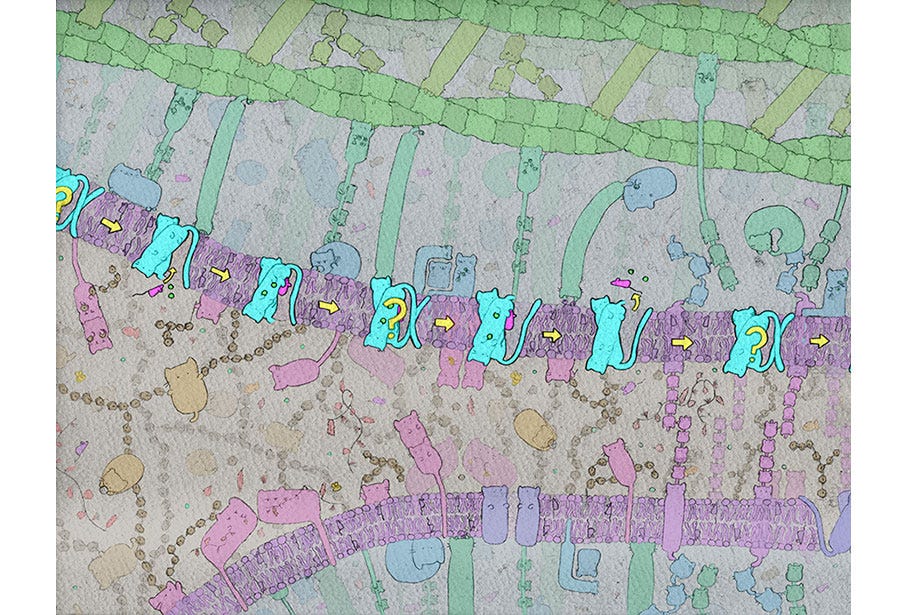#19: String Theories
“The thing about communicating science today is…people can always watch cat videos instead...”
On the main road up the street from her house, my friend Mel found a willowy, long-haired grey tabby with big green eyes that had just been hit by a car. Without another thought, Mel scooped up the petite cat and rushed to the vet to get her checked out. She also planned on getting the cat scheduled for spaying; her little girl already naming the cat, and thus resigning her to keeping the cat after this check-up.
Thankfully, Flower the Cat was fine from her ordeal, but could not be spayed until she gave birth to the three kittens she carried.
After the kittens were born and close to weaning, I went over to Mel’s house to pick out one. The little girl had also given the kittens their names: Rose was also a small fluffy grey tabby, just like her mom; Teddy was a boisterous, short-haired greyish tabby boy. He was going to a bruiser. And then there was Melbourne O’Reilly - a smoky, scowling, short-hair that hid from everyone, including her siblings, underneath a bed in a spare room.
We don’t know why she named the cat that, but having never been to Melbourne, I renamed her Katoomba, a beautiful place in southeastern Australia I had visited two years earlier. Other than the new moniker, though, little else has changed about her in the nearly 16 years since. (If you follow me on Twitter, you’ll see the occasional reference to the infamous “Bitchy Cat”.)
Backed by the white noise of crickets, my mornings start more or less in the same manner - with a mug of coffee, and the space and time to explore ideas. As I mull over various threads I’ve begun for future posts, Katoomba quietly joins me and nestles into my lap.1 Although there’s nothing specific about her presence this morning, she draws my attention to a recent tweet I saw, in which Dr. Sarah Knowles (@dr_know) shares her poster on developing learning health systems in the North of England.
While most research posters (self included) are wonderful aides for the chronic insomniac, I would definitely ask Dr. Knowles about the Connected Health Cities study - and, of course, Max.
I mean, look at him.
Katoomba rearranges herself on my legs, a 5lb ball of intense heat (and intense hate for most everything else), and I start wondering if others have used cats as a muse in scientific messaging. This is the nature of my thinking - chasing a laser pointer in my mind to other similar ideas.
And reliably, when it comes to kitties, the internet is a rich trove of inspiration. For example, pandemics and public health.2 This tweet3 gets good engagement for sharing a modified “flattening the curve” that adds the dotted line of the healthcare system.
However, Dr. Anne Marie Darling (@amdar1ing) looked a similar version of the chart (published by Vox), saw that the shapes looked like an “alert” and a “lazy” kitty, and knew that a redesign of the image would be far more compelling. With 53K+ likes and 27K+ retweets, “cattening” the curve definitely grabbed more attention.
Katoomba has since had her fill of human contact, and has taken up residence on an opposite chair, curled into her patented “hate loaf” position. But I keep chasing the tangents, wondering who else has used cat metaphors - big stretches, chasing mice, playing with balls of yarn, or knocking glasses off counters - to tell small stories about scientific processes. I find lots of posts of cats interrupting their servants, and then I find Dr. Fiona Naughton (@ExplainedByCats - a moment for that handle, please), who draws, then digitally paints, the structure of a coronavirus or the process of recycling bile acids in the digestive tract using cats. Adorable.
Do cats have anything to do with any of the science shared here? Of course not. But it makes you pause (maybe even smile), and I think it makes the science, and the scientist behind it, approachable:
…Science is often very complex, and pretty much anyone outside your field will need something they can relate to—a familiar concept that they can use to begin to explore the new territory.” (Brickhill, 2016)
Yet in this cursory search on using metaphor in knowledge translation, there appears to be some debate. On the other paw hand, some warn that using metaphors may have unintentional consequences that need to be considered (i.e., using gendered metaphors, or terms with militaristic or racist histories):
…not only to the ways in which metaphors may contribute to public misunderstanding, but also to how their use may unintentionally reinforce particular social and political messages that undermine the goals of inclusive science.” (Taylor & Dewsbury, 2018)
“Fair point”, I think, and make a note in my notebook to reflect more on this idea as I slowly rise from my hour of quiet. I look over to the chair opposite, and the tiny grey fluff. Katoomba has been with me since 2006, seeing me through dissertation and new addresses and a family. Lately, she is showing more signs of her age, a bit more clingy and vocal than she used to be. I know she doesn’t have much more science to observe with her judging glare.
I give her a head scritch. She chirps, then scowls and turns around to fall back asleep, as I walk off to start my day.
This, too, is not unusual. She’s quite affectionate with me, pretty good with my husband and tolerant of my stepson, who learned to let her come to him.
Aside from having our fluffy friends include themselves in our meetings, of course. Or having us turn into cats because of delightful Zoom filters.
I found Drew’s tweet through this article, which also finds that the versions of that graph didn’t do much to alter behaviours (although that’s likely not a surprise to us, two years later with the benefit of hindsight).










Purr-fect story! I always like seeing kitties and cats. A lot of interesting information. By the way, there is a Melbourne in Florida too. I lived there for many years.
Such a fascinating post, Bryn!
CAT-tenning the curve - absolutely an attention grabber! :D